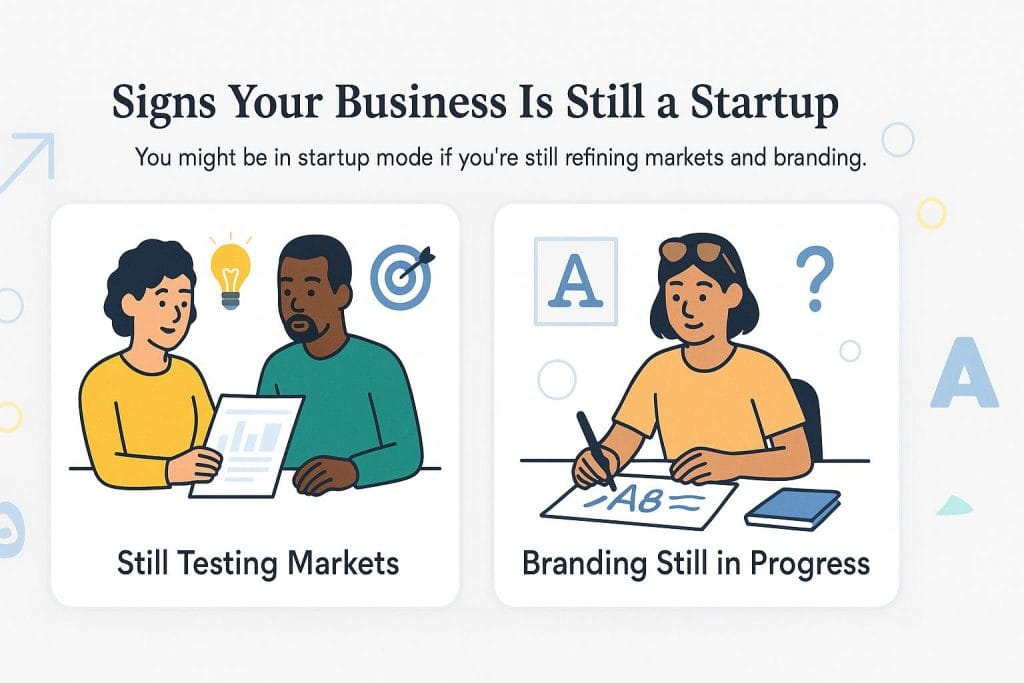Business.com aims to help business owners make informed decisions to support and grow their companies. We research and recommend products and services suitable for various business types, investing thousands of hours each year in this process.
As a business, we need to generate revenue to sustain our content. We have financial relationships with some companies we cover, earning commissions when readers purchase from our partners or share information about their needs. These relationships do not dictate our advice and recommendations. Our editorial team independently evaluates and recommends products and services based on their research and expertise. Learn more about our process and partners here.
When Are You No Longer a Startup?
Though many companies refer to themselves as startups long after their launch, there are some clear signs a business no longer fits that category.

Table of Contents
There is no set benchmark for when your business stops being a startup. It takes some organizations longer than others to go through all the necessary changes to evolve from startup to established business. Below, we’ll examine what distinguishes a startup from an established business, and how you can tell which applies to your business.
What defines a startup?

There is no standardized definition of a startup, but the term generally refers to a new business that is raising money with a goal of relatively rapid near-term growth. To better understand what might constitute a startup, it may be helpful to consider definitions of small and emerging businesses from the SBA and SEC.
According to the U.S. Small Business Administration (SBA), small businesses generally have fewer than 500 employees and meet specific revenue thresholds that vary by industry. While not all startups qualify as small businesses, understanding these official definitions provides valuable context for business classification.
The U.S. Securities and Exchange Commission (SEC) defines “emerging growth companies” as businesses with total annual gross revenues of less than $1.235 billion during their most recently completed fiscal year, provided they haven’t sold common equity securities under a registration statement before December 8, 2011. These companies can maintain emerging growth status for up to five years after their IPO.
Why definitions of “startup” vary
The definition of “startup” varies significantly across industries and contexts. In rapidly evolving tech sectors, companies may maintain startup-like cultures and growth patterns even after reaching traditional graduation benchmarks.
Some established companies intentionally maintain “startup culture” to preserve innovation and agility. This approach recognizes that bureaucratic processes can stifle creativity and rapid decision-making that drove initial success. However, this cultural choice doesn’t negate the practical reality of business maturity markers like revenue scale, employee count and market position.
Conversely, some businesses may resist the startup label due to perceived instability. With startup failure rates at 90% globally, and one-third failing due to lack of product demand, some companies prefer to position themselves as established businesses to attract customers and talent who value stability.
Signs your business is no longer a startup
If there’s no standard definition of a startup, how can you tell if your business is one or not? These signs suggest your business has transitioned out of the startup phase and has become an established company.
You’re acquiring other companies
One of the strongest signs your business is no longer a startup is you are acquiring, or looking to acquire, other companies. This could be for a number of reasons. Recruiting talent is incredibly competitive. So, instead of trying to poach top-tier candidates from other companies, it may be more beneficial or cost-effective to acquire a company with the talent you desire.
Another reason to acquire other businesses is to control more verticals, giving your company more of a competitive edge in the industry. When a business is in a position to purchase another company, they have the capital and workforce to be a competitive business.
You have a mature product or service
At their inception, startups are often researching the market by evaluating their products or services compared to successful companies. Once a business has achieved its desired product or service and is actively selling it, it has adjusted to the market. Having a complete product that is sold, while also developing updates or new products, is a sign a company has moved beyond its startup phase.
You have a formal management structure
Startups usually have an informal chain of command and a loose management style in the beginning. Since the initial team may be small and nimble, there’s an opportunity to be avant-garde.
As the team grows, the company is likely to become more bureaucratic. Leaders and executives tend to use more official and formal channels of communication. It’s common for companies to develop standardized operating procedures (SOPs) as well. This type of structure is implemented for the sake of clarity and consistency among the staff. When processes become less flexible and more formal, a startup has begun transitioning to an established business.
You’re publicly traded
For startups, becoming publicly traded is usually a milestone that marks the transition to fully established business. It’s a chance for the public to buy and sell stocks of your company, which can often prove fruitful for those running the business.
Your underwriter in the IPO process is looking for requirements like consistent revenue, growth potential and promising management. Even just having the option to go public is a sign that your startup has achieved significant growth and development.
You meet financial benchmarks
Since startups are often reliant on seed capital, financial benchmarks can be an effective way to measure your growth. One of the most well-known growth frameworks is the 50-100-500 rule. Using this yardstick, your company is no longer a startup if you have a $50 million revenue run rate, 100 or more employees, or are worth over $500 million.
However, the 50-100-500 rule is not the only metric to measure whether your business is a startup. You may be considered to be out of your startup stage once you raise over $1 million, grow your team more than 20 percent each year or engage in international business.
Self-assessment checklist: Are you still a startup?
Use this practical checklist to evaluate your company’s current status.
Product and market validation
- Is your business model firmly established with a clear hierarchical structure?
- Do you have a clearly defined target market with proven demand?
- Has your product or service achieved product-market fit?
- Are you generating consistent, predictable revenue?
Organizational structure
- Do you have formal job descriptions and reporting structures?
- Have you hired key C-Suite executives for specialized roles?
- Are your processes documented and standardized?
- Do you have clear internal communication channels and policies?
Financial metrics
- Have you exceeded $1 million in annual revenue?
- Do you have more than 20 employees?
- Are you profitable or have a clear path to profitability?
- Have you raised Series A funding or beyond?
Market position
- Are you acquiring other companies or being courted for acquisition?
- Do you have established brand recognition in your industry?
- Are you competing directly with established players rather than creating new market categories?
- Do you have international operations or customers?
If you answered “yes” to most questions in multiple categories, you may have graduated from startup status.
Signs you’re still in startup territory
You’re still testing foundational business ideas
You are still in the startup phase if your company is currently testing foundational business ideas and taking them to market. It could take years to identify your target audience and finalize its concept. After you do, you still need to determine how to stand out in the marketplace. Once your company is out of the brainstorming phase and your prototypes become final products with a clear sales plan, then your business has grown beyond the startup phase. [Related article: How to Create a Marketing Plan for Your Startup]
You don’t have a solidified brand
Initially, startups are usually so focused on developing their product that they don’t have a clear brand. A solidified brand makes your business identifiable to consumers, but that comes once you’ve established your product line, company mission and culture.
It could take time to create a name, logo, visual style and written tone that represents your organization. And those things may change as your company develops new products or modifies its goals. If your business is still developing its brand, then you may not be ready to graduate to the big leagues.
You still need to hire essential employees
A startup is often still in the process of hiring its most essential employees. In the beginning, the founder typically assumes all or most of the company’s responsibilities and, as the business grows, they begin to hire staff to fill the most critical roles. These roles include a chief executive officer (CEO) and a chief operations officer (COO) to ensure the organization is running smoothly, a product manager to oversee the development and release of your product, and an accountant to manage the company’s finances. If these roles remain vacant, your business is likely still a startup.
Current startup market context
The startup landscape in 2024 reflects both challenges and opportunities. Global venture funding totaled $66.5 billion in Q3 2024, representing a 15% year-over-year decline, according to Demand Sage.
For emerging growth companies, the current environment requires stronger fundamentals. Investors are taking 20% longer to make decisions, with increased focus on startups demonstrating clear product-market fit and sustainable growth. This shift benefits companies that have moved beyond the initial startup phase and can demonstrate proven business models.
The rise of AI has created new categories of startups and scaleups. In 2023, 30% of venture capital funding went to AI startups, according to data from thinslices. The AI boom is creating an entirely new ecosystem of companies that may follow different growth trajectories than traditional startups.
The transition from startup to established business is gradual
The graduation from startup to established business isn’t a binary transition — it’s a spectrum. Companies may exhibit startup characteristics in some areas while showing maturity in others. A business might have formal structures and substantial revenue but still maintain the innovative culture and rapid decision-making that characterizes startups.
As your business evolves, embrace the advantages of each stage while remaining true to the entrepreneurial spirit that drove your initial success. The goal isn’t to shed your startup identity completely, but to evolve it into something sustainable and scalable for long-term success.







